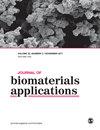Preparation and osteogenesis of a multiple crosslinking silk fibroin/carboxymethyl chitosan/sodium alginate composite scaffold loading with mesoporous silica/poly (lactic acid-glycolic acid) microspheres.
IF 2.3
4区 医学
Q3 ENGINEERING, BIOMEDICAL
引用次数: 0
Abstract
Large bone defect repair is a striking challenge in orthopedics. Currently, inorganic-organic composite scaffolds are considered as a promising approach to these bone regeneration. Silicon ions (Si4+) are bioactive and beneficial to bone regeneration and Si4+-containing inorganic mesoporous silica (MS) can effectively load drugs for bone repair. To better control the release of drug, we prepared biodegradable MS/PLGA (MP) microspheres. MP loaded organic silk fibroin/carboxymethyl chitosan/sodium alginate (MP/SF/CMCS/SA) composite scaffolds were further constructed by genipin and Ca2+ crosslinking. All MP/SF/CMCS/SA scaffolds had good swelling ability, degradation rate and high porosity. The incorporation of 1% MP significantly enhanced the compressive strength of composite scaffolds. Besides, MP loaded scaffold showed a sustained release of Si4+ and Ca2+. Moreover, the release rate of rhodamine (a model drug) of MP/SF/CMCS/SA scaffolds was obviously lower than that of MP. When culturing with rat bone marrow mesenchymal stem cells, scaffolds with 1% MP displayed good proliferation, adhesion and enhanced osteogenic differentiation ability. Based on the results above, the addition of 1% MP in SF/CMCS/SA scaffolds is a prospective way for drug release in bone regeneration and is promising for further in vivo bone repair applications.负载介孔二氧化硅/聚(乳酸-乙醇酸)微球的多重交联蚕丝纤维素/羧甲基壳聚糖/海藻酸钠复合支架的制备与成骨。
大面积骨缺损修复是整形外科面临的一项严峻挑战。目前,无机-有机复合支架被认为是一种很有前景的骨再生方法。硅离子(Si4+)具有生物活性,有利于骨再生,而含 Si4+ 的无机介孔二氧化硅(MS)能有效负载药物,用于骨修复。为了更好地控制药物释放,我们制备了可生物降解的 MS/PLGA (MP)微球。通过基因素和 Ca2+ 交联,进一步构建了负载 MP 的有机丝纤维素/羧甲基壳聚糖/海藻酸钠(MP/SF/CMCS/SA)复合支架。所有 MP/SF/CMCS/SA 支架都具有良好的膨胀能力、降解率和高孔隙率。1% 的 MP 能显著提高复合材料支架的抗压强度。此外,负载 MP 的支架显示出 Si4+ 和 Ca2+ 的持续释放。此外,MP/SF/CMCS/SA 支架的罗丹明(一种模型药物)释放率明显低于 MP。在培养大鼠骨髓间充质干细胞时,含有 1%MP的支架显示出良好的增殖、粘附和成骨分化能力。基于上述结果,在 SF/CMCS/SA 支架中添加 1%的 MP 是骨再生中药物释放的一种前瞻性方法,有望进一步应用于体内骨修复。
本文章由计算机程序翻译,如有差异,请以英文原文为准。
求助全文
约1分钟内获得全文
求助全文
来源期刊

Journal of Biomaterials Applications
工程技术-材料科学:生物材料
CiteScore
5.10
自引率
3.40%
发文量
144
审稿时长
1.5 months
期刊介绍:
The Journal of Biomaterials Applications is a fully peer reviewed international journal that publishes original research and review articles that emphasize the development, manufacture and clinical applications of biomaterials.
Peer-reviewed articles by biomedical specialists from around the world cover:
New developments in biomaterials, R&D, properties and performance, evaluation and applications
Applications in biomedical materials and devices - from sutures and wound dressings to biosensors and cardiovascular devices
Current findings in biological compatibility/incompatibility of biomaterials
The Journal of Biomaterials Applications publishes original articles that emphasize the development, manufacture and clinical applications of biomaterials. Biomaterials continue to be one of the most rapidly growing areas of research in plastics today and certainly one of the biggest technical challenges, since biomaterial performance is dependent on polymer compatibility with the aggressive biological environment. The Journal cuts across disciplines and focuses on medical research and topics that present the broadest view of practical applications of biomaterials in actual clinical use.
The Journal of Biomaterial Applications is devoted to new and emerging biomaterials technologies, particularly focusing on the many applications which are under development at industrial biomedical and polymer research facilities, as well as the ongoing activities in academic, medical and applied clinical uses of devices.
文献相关原料
公司名称
产品信息
阿拉丁
sodium alginate
 求助内容:
求助内容: 应助结果提醒方式:
应助结果提醒方式:


